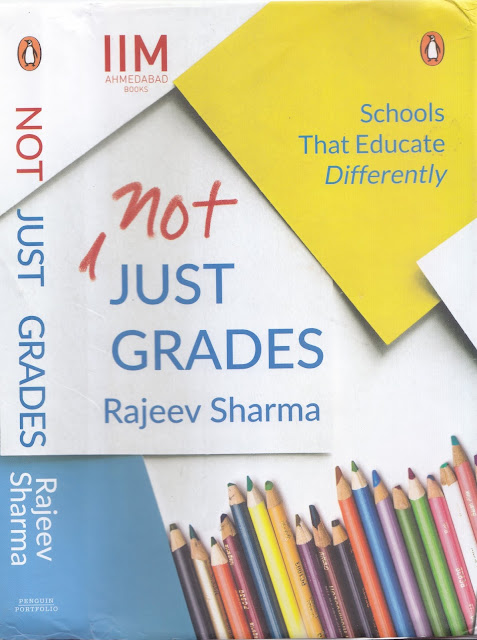Schools beyond textbooks
Schools
beyond textbooks
Title:
Not just Grades – Schools That Educate Differently
Author:
Rajeev Sharma
Publishers:
Portfolio Penguin -An imprint of Penguin Random House
IIM
Ahmedabad Books
Number
of Pages: 389
Price:
599/-
Published
in Teacher Plus’ February 2019 issue.
Thanks
are due to the team at Teacher Plus.
The
preface and introduction are clear and concise. They convey what the book is
all about and whom it caters to. Schools, the book tells us, are not free of
the social and political contexts they are located in. Like children, they have
a life beyond textbooks. This is the life the book focuses on.
More
than a book which talks of ‘schools that educate differently’, this is a book about
school leadership. A book meant for practitioners, which addresses the need of
the hour. The language is simple, direct and free of jargon. It will not only
help school leaders and aspiring school leaders to avoid reinventing the wheel
but also to raise questions. Questions that give birth to fresh thoughts and
ideas.
Ten
casestudies (each a different school) from across the country, primarily from
the western states, have been placed together. Collated over a period of 10
years these case studies present a positive picture, one that gives hope. They
talk of a diverse set of schools - crucial in today’s time when more and more
schools appear to be functioning in a similar fashion. Annexures appended to
the chapters share further details and learning is summarized in the final two
chapters.
The
schools discussed are not the elite schools that the majority cannot afford. These
are, however, fairly large schools with student numbers ranging from 1,000 to
5,000. It also helps that the case studies are recent — the schools belong from
the recent generation. They face challenges different from those of their
better known predecessors. These case studies detail how they met these
challenges. The message that the reader gets is that if it is possible to catalyse
positive change in such large yet diversely set schools it can surely take
place in relatively smaller schools.
There
is some element to learn from each case study. One had taken up an exercise to plan
major changes in the school’s functioning – this was done over a year by freeing
select teachers from teaching during the period. Another school works in two
separate shifts – one for children staying less than five kms away and another for
those staying beyond five kms. Yet another school administers two sets of
question papers. The idea is to ‘enable
the less bright children to do reasonably well’. These actions are location
specific but they make the readers aware to the possibilities of what they can
take up in their schools.
These
case studies are based on interactions with school managements. Some lines therein
underscore the clarity of the managements and leaders. These include: ‘Schools should not only be full of
‘rituals’ arising from too much of attention on tangibles such as class work,
exams, corrections, lesson plans and similar things; rather, it should be a way
of life that shines out to others by its openness’. And ‘If a child has failed in his class he is
given admission in this school. If he has failed twice he is given priority in
admission.’
Editing
though could have been crisper. Three of the ten case studies are long, 45 - 50
pages each. The initial two chapters together takeup 45 pages. One wonders about the
need for the chapters in this form especially when the author points out that
the book is meant for ‘educational
leaders, heads of schools and policymakers’.
The
author takes a conventional route many a time like when he states that music
and arts help enhance academic performance. Can we not have music and arts for their own
sake? He also appears to have taken a neutral approach in the case studies.
While he appreciates the leadership he neither questions nor flags the grey
areas. At one of the schools, a well-known personality is placed on a pedestal
and appears to be calling the shots while his role is unclear. At another
school, ‘children were beaten up mildly
if they did not change through persuasion’.
The
book does not delve into environment education (discussions on sustainability),
or talk about the impact of mobile phones on students (and the resultant impact
on schools) or Right to Education – areas many schools today face dilemmas in. One
wonders if this has to do more with the author than with the schools
themselves.
All
said and done this is a book that talks about schools which took the initiative
to react to the changes around them, rather than wait for the world to change.
At the same time they also stuck to the basics – like to the adage of schools being only as good as their teachers.
This was achieved by employing a mix of approaches and enabling linkages. In a
nutshell the book underscores the need for clarity in management and dynamism in
leadership, and the need to be open to change and innovation while not losing
sight of the thumb rules. This is a book that school leaders and aspiring
leaders will do well to read.
Previous book-review on Education for Teacher Plus here.


Comments
Post a Comment